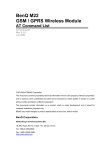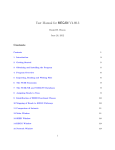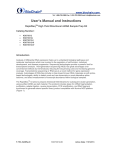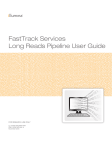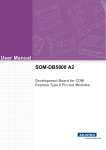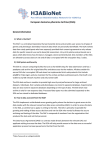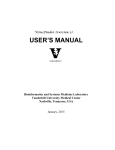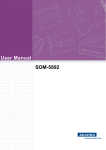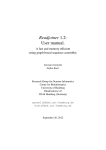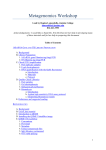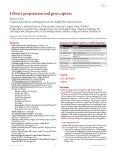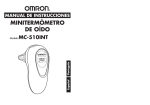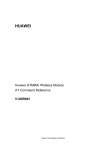Download Skewer - The UK Mirror Service
Transcript
Skewer: A fast and accurate adapter trimmer for paired-end reads User’s Manual Hongshan Jiang Chinese Academy of Inspection and Quarantine May 12, 2015 Permission is hereby granted, free of charge, to any person obtaining a copy of this software and associated documentation files (the ”Software”), to deal in the Software without restriction, including without limitation the rights to use, copy, modify, merge, publish, distribute, sublicense, and/or sell copies of the Software, and to permit persons to whom the Software is furnished to do so, subject to the following conditions: The above copyright notice and this permission notice shall be included in all copies or substantial portions of the Software. THE SOFTWARE IS PROVIDED ”AS IS”, WITHOUT WARRANTY OF ANY KIND, EXPRESS OR IMPLIED, INCLUDING BUT NOT LIMITED TO THE WARRANTIES OF MERCHANTABILITY, FITNESS FOR A PARTICULAR PURPOSE AND NONINFRINGEMENT. IN NO EVENT SHALL THE AUTHORS OR COPYRIGHT HOLDERS BE LIABLE FOR ANY CLAIM, DAMAGES OR OTHER LIABILITY, WHETHER IN AN ACTION OF CONTRACT, TORT OR OTHERWISE, ARISING FROM, OUT OF OR IN CONNECTION WITH THE SOFTWARE OR THE USE OR OTHER DEALINGS IN THE SOFTWARE. c Copyright 2013-2015, Chinese Academy of Inspection and Quarantine. All rights reserved. Release # Rev. 0.1.76 Rev. 0.1.88 Rev. 0.1.104 Date 09/26/2013 10/16/2013 01/14/2014 Rev. 0.1.112 03/05/2014 Rev. 0.1.120 09/27/2014 Rev. 0.1.124 03/09/2015 Rev. 0.1.125 05/12/2015 Description First public release Barcode demultiplexing O(kn) worst time complexity Nextera Long Mate Pair (LMP) adapter trimming; trimming modes (HEAD, ANY, TAIL) Amplicon paired reads (Bidirectional 5’ trimming) First OS X version Capability of producing QIIME-compatible files for microbial analysis 1 Table of Contents 1 General Information 3 1.1 Overview . . . . . . . . . . . . . . . . . . . . . . . . . . . . . . . . . . 3 1.2 Citation . . . . . . . . . . . . . . . . . . . . . . . . . . . . . . . . . . 3 2 Getting Started 4 2.1 Installation . . . . . . . . . . . . . . . . . . . . . . . . . . . . . . . . 4 2.1.1 System Requirements . . . . . . . . . . . . . . . . . . . . . . . 4 2.1.2 Install from Binary Package . . . . . . . . . . . . . . . . . . . 4 2.2 For Impatient Users . . . . . . . . . . . . . . . . . . . . . . . . . . . . 5 3 Using the Program 7 3.1 Usage . . . . . . . . . . . . . . . . . . . . . . . . . . . . . . . . . . . 7 3.2 Options . . . . . . . . . . . . . . . . . . . . . . . . . . . . . . . . . . 7 3.2.1 Adapter . . . . . . . . . . . . . . . . . . . . . . . . . . . . . . 7 3.2.2 Tolerance . . . . . . . . . . . . . . . . . . . . . . . . . . . . . 9 3.2.3 Filtering . . . . . . . . . . . . . . . . . . . . . . . . . . . . . . 9 3.2.4 Input/Output . . . . . . . . . . . . . . . . . . . . . . . . . . . 10 3.2.5 Miscellaneous . . . . . . . . . . . . . . . . . . . . . . . . . . . 11 4 Source Codes 12 2 Chapter 1 General Information 1.1 Overview The Skewer program implements a novel dynamic programming algorithm dedicated to the task of adapter trimming and it is specially designed for processsing Illuminar paired-end sequences. Skewer got its name because the implemented algorithm utilizes the equality of diagonal adjacent elements in the dynamic programming matrix where these elements could be ‘skewered’ together by such a tool. Skewer has the following features: • • • • • • • • Detection and removal of adapter sequences Insertion and deletion allowed in pattern matching Targeted at Single End, Paired End (PE), and Long Mate Pair (LMP) reads Demultiplexing of barcoded sequencing runs Multi-threading support Trimming based on phred quality scores IUPAC characters for barcodes and adapters Compressed input and output support The program is available at https://sourceforge.net/projects/skewer. 1.2 Citation Jiang, H., Lei, R., Ding, S.W. and Zhu, S. (2014) Skewer: a fast and accurate adapter trimmer for next-generation sequencing paired-end reads. BMC Bioinformatics, 15, 182. 3 Chapter 2 Getting Started 2.1 2.1.1 Installation System Requirements CPU RAM Operating System Pre-requisites 2.1.2 64 bit Intel or AMD CPU 30M per CPU (core) x86 64 GNU Linux none Install from Binary Package Instructions: Move skewer-x.x.x-linux-x86 64 to a directory ‘INSTALL DIR’ where the software is to be installed. $ mv skewer-x.x.x-linx-x86_64 INSTALL_DIR/skewer For convenience, you should add ‘INSTALL DIR/’ into the environmental variable $PATH by adding a line ‘export PATH=INSTALL DIR/:$PATH’ to ∼/.bashrc followed by command ‘. ∼/.bashrc’. $ echo "export PATH=INSTALL_DIR/:$PATH" >> ~/.bashrc $ . ~/.bashrc 4 Getting Started 2.2 For Impatient Users Basically, the usage format of skewer is: $ skewer [options] <reads-pair1.fastq> [<reads-pair2.fastq>] where the primary options are as follows: • options ‘-x’ and ‘-y’ are required for most of the cases, for specifying the forward adapter(s)/primer(s) and the reverse adapter(s)/primer(s); • option ‘-m’ is used for specifying trimming mode, such as head mode, tail mode, anywhere mode, paired-end mode, mate-pair mode, and amplicon mode; • options ‘-r’, ‘-d’, and ‘-k’ are used for specifying trimming stringency; • options ‘-q’ and ‘-Q’ are used for quality-based trimming or filtering; • options ‘-l’ and ‘L’ are used for length-based filtering; • option ‘-t’ is used for multithreading. Examples are as follows: 1. To trim the sequences in adpaters.fa from sample.fastq, filter out those reads that have an average phred-score below 9, and output the trimmed reads to out-trimmed.fastq: $ skewer -Q 9 -t 2 -x adapters.fa sample.fastq -o out 2. To do adapter trimming for the compressed files data-pair1.fq.gz and datapair2.fq.gz with the adapter sequence of AGATCGGAAGAGC, and do 3’ end quality trimming with a quality threshold of 3: $ skewer -x AGATCGGAAGAGC -q 3 data-pair1.fq.gz data-pair2.fq.gz 3. To trim adapter sequence TCGTATGCCGTCTTCTGCTTGT from smallRNA reads srna.fastq, not allowing insertion/deletion in adapter detection, and only output those reads that have a length between 16 and 30 after adapter trimming: $ skewer -x TCGTATGCCGTCTTCTGCTTGT -l 16 -L 30 -d 0 srna.fastq 4. To do adapter trimming from lmp-pair1.fastq and lmp-pair2.fastq using Long Mate Pair mode, and redistribute reads based on junction information: 5 Getting Started $ skewer -m mp -i lmp-pair1.fastq lmp-pair2.fastq 5. To trim barcodes which are the 6 leading nt at the 5’ end of the reverse primer of the amplicon sequences in mix-pair1.fastq and mix-pair2.fastq, output those barcodes to barcodes.fastq and mapping file.txt as well as the trimmed reads for downstream analysis (such as those by QIIME): $ skewer -m ap --cut 0,6 --qiime -x forward-primers.fa \ -y reverse-primers.fa mix-pair1.fastq mix-pair2.fastq where an example of the mapping file.txt required by QIIME looks like this: #SampleID BarcodeSequence LinkerPrimerSequence ReversePrimer Description A01 TCGAAT GTGCCAGCMGCCGCGGTAA GGACTACHVGGGTWTCTAAT NA A02 CATGGC GTGCCAGCMGCCGCGGTAA GGACTACHVGGGTWTCTAAT NA A03 AGCTTA GTGCCAGCMGCCGCGGTAA GGACTACHVGGGTWTCTAAT NA A04 GTACCG GTGCCAGCMGCCGCGGTAA GGACTACHVGGGTWTCTAAT NA A05 CTATGA GTGCCAGCMGCCGCGGTAA GGACTACHVGGGTWTCTAAT NA A06 ACGCTG GTGCCAGCMGCCGCGGTAA GGACTACHVGGGTWTCTAAT NA A07 GATACT GTGCCAGCMGCCGCGGTAA GGACTACHVGGGTWTCTAAT NA A08 TGCGAC GTGCCAGCMGCCGCGGTAA GGACTACHVGGGTWTCTAAT NA A09 GCTTAA GTGCCAGCMGCCGCGGTAA GGACTACHVGGGTWTCTAAT NA A10 TACCGG GTGCCAGCMGCCGCGGTAA GGACTACHVGGGTWTCTAAT NA A11 CGAATT GTGCCAGCMGCCGCGGTAA GGACTACHVGGGTWTCTAAT NA A12 ATGGCC GTGCCAGCMGCCGCGGTAA GGACTACHVGGGTWTCTAAT NA 6 Chapter 3 Using the Program 3.1 Usage $ skewer [options] <reads-pair1.fastq> [<reads-pair2.fastq>] 3.2 Options 3.2.1 Adapter -x <string> Adapter sequence/file for the first reads. If it’s not specified, the adapter sequence is ‘AGATCGGAAGAGCACACGTCTGAACTCCAGTCAC’ by default. If there’s a dot in the string, then it’s recognized as the filename of the FASTA file that contains adapter sequences. -y <string> Adapter sequence/file for the second reads. If it’s not specified, the adapter sequence is ‘AGATCGGAAGAGCGTCGTGTAGGGAAAGAGTGTA’ by default. If there’s a dot in the string, then it’s recognized as the filename of the FASTA file that contains adapter sequences. If -x is the only one specified explicitly, then -y is implied by -x. -M, --matrix <string> TAB delimited file indicates valid forward/reverse adapter pairing. For the specified forward and reverse adapter sequences, the matrix contained in the 7 Using the Program specified file further denotes the valid combinations. It is an all ones matrix by default. The following matrix specifies that the forward/reverse adapter combinations A2, A3, B2, B3, C1, D1, D2, D3, and D4 are valid, where forward adapters are numbered as ‘A’, ‘B’, ‘C’, ‘D’, . . . while reverse adapters are numbered as ‘1’, ‘2’, ‘3’, ‘4’, . . . . %* or *% denote match of a single adapter. # % A B C D % 0 0 0 0 0 1 0 0 0 1 1 2 0 1 1 0 1 3 0 1 1 0 1 4 0 0 0 0 1 -j <string> Junction adapter sequence/file for Nextera Mate Pair reads. The junction adapter sequence is ‘CTGTCTCTTATACACATCTAGATGTGTATAAGAGACAG’ by default. If there’s a dot in the string, then it’s recognized as the filename of the FASTA file that contains junction adapter sequences. -m, --mode <string> trimming mode. For single end reads, the valid modes are ‘head ’ for 5’ end trimming; ‘tail ’ for 3’ end trimming; ‘any’ for anywhere adapter detection and trimming. For paired end reads, the valid modes are ‘pe’ for paired-end trimming; ‘mp’ for mate-pair trimming; ‘ap’ for amplicon trimming besides ‘head ’, ‘tail ’, and ‘any’ which specifies separate single end trimming for paired reads. In amplicon mode, the forward/reverse primers will not be trimmed off because they are informative for downstream analysis. -b, --barcode Whether to demultiplex reads according to adapters/primers. The default is no. -c, --cut <integer>,<integer> To hard clip off the 5’ leading bases of the forward primer and reverse primer respectively as the barcodes in amplicon mode. The default is 0,0. 8 Using the Program 3.2.2 Tolerance -r <number> Maximum allowed error rate. The error rate is defined as the normalized number of errors (refer to section 1.2) considering the phred quality scores divided by the length of aligned region. The valid range of error rate is [0, 0.5]. The default value is 0.1. -d <number> Maximum allowed indel error rate. The indel error rate is defined as the number of indels multiplied by the maximum penalty of a mismatch (refer to section 1.2) divided by the length of aligned region. The valid range of indel error rate is [0, r], where r is the maximum allowed error rate. The default value is 0.03. -k <integer> Minimum overlap length for adapter detection. For single-end reads trimming or single-end trimming of paired-end reads, the default value is max(1, int(4−10∗r). For mate-pair reads, the default value is half of the length of corresponding junction adapter. 3.2.3 Filtering -q, --end-quality <integer> 3’ end quality trimming. Trim 3’ end until specified or higher quality reached. The default value is 0. -Q, --mean-quality <integer> Reads filtering by average quality. Specifies the lowest mean quality value allowed before trimming. The default value is 0. -l, --min <integer> Minimum read length allowed after trimming. The default value is 18. -L, --max <integer> Maximum read length allowed after trimming. There’s no limit by default. 9 Using the Program -n Whether to filter out highly degenerative reads, where highly degenerative reads are defined as those reads that above 15% of the nucleotides are ‘N’. The default is no. -u Whether to filter out undetermined mate-pair reads, where undetermined mate-pair reads are defined as those mate-pair reads that neither of the paired reads has the junction adapter sequence detected. The default is no. 3.2.4 Input/Output -f, --format <string> Format of FASTQ quality value. The valid options are ‘sanger ’, ‘solexa’, ‘auto’. The default value is ‘auto’. -o, --output <string> Base name of output file. This specifies the prefix of output files. The default value is ‘<reads>-trimmed’, where <reads> is the base name of input file. -z, --compress Whether to compress output in GZIP format. The default is no. -1, --stdout Whether to redirect output to STDOUT. This option suppresses the ‘-b’, ‘-o’, and ‘-z’ options. The default is no. --qiime Whether to prepare files required by QIIME. If specified, the ”barcodes.fastq” and ”mapping file.txt” will be prepared for downstream analysis with QIIME. This option must be used with ‘–cut’ option and will suppress ‘–barcode’ option. The default is no. --quiet Whether in quiet mode. When specified, there will be no progress update. The default is no. 10 Using the Program 3.2.5 Miscellaneous -i, --intelligent Whether to intelligently redistribute reads. When specified, mate-pair reads will be redistributed based on detected junction information. The default is no. -t, --threads <integer> Number of concurrent threads. The valid number is an integer between 1 and 32. The default value is 1. 11 Chapter 4 Source Codes Source codes are deposited at https://github.com/relipmoc/skewer. 12













